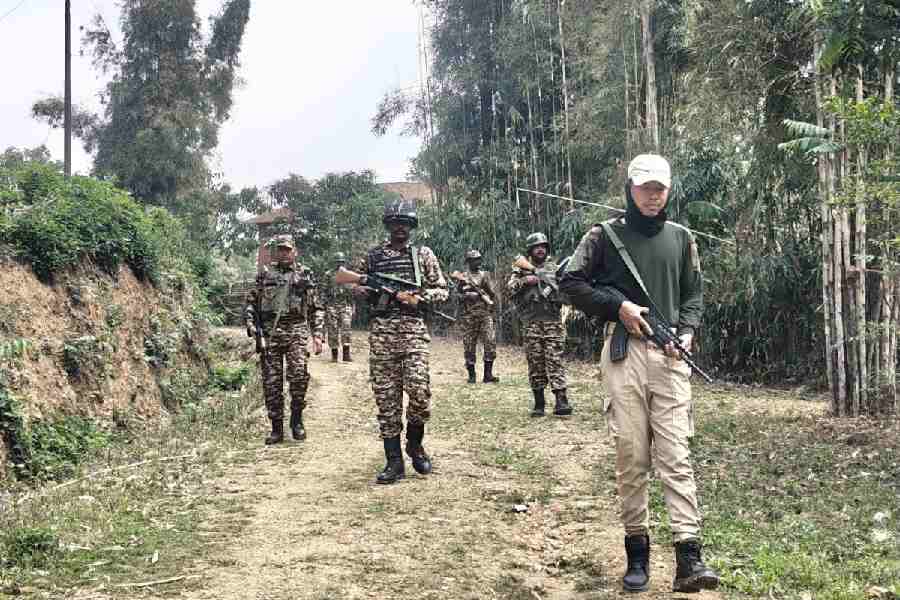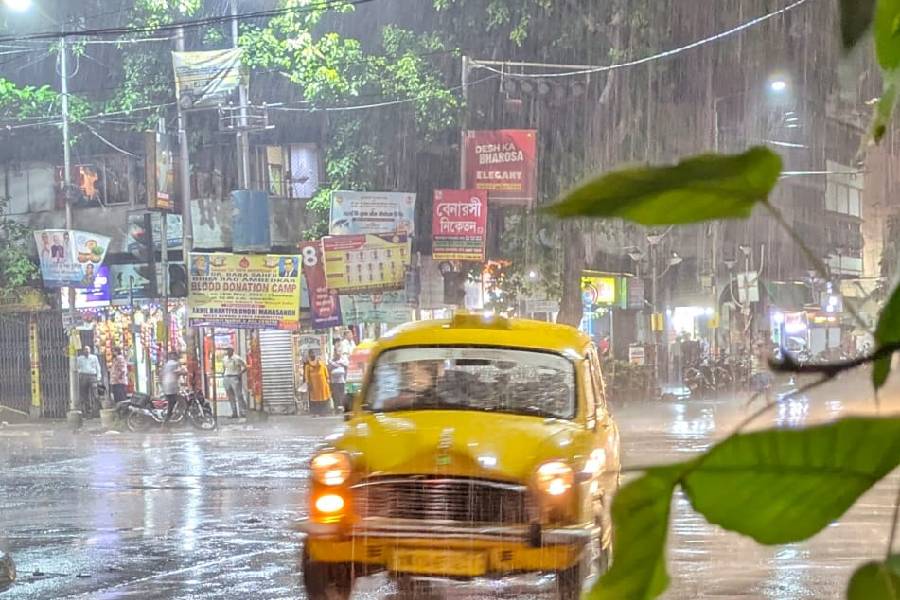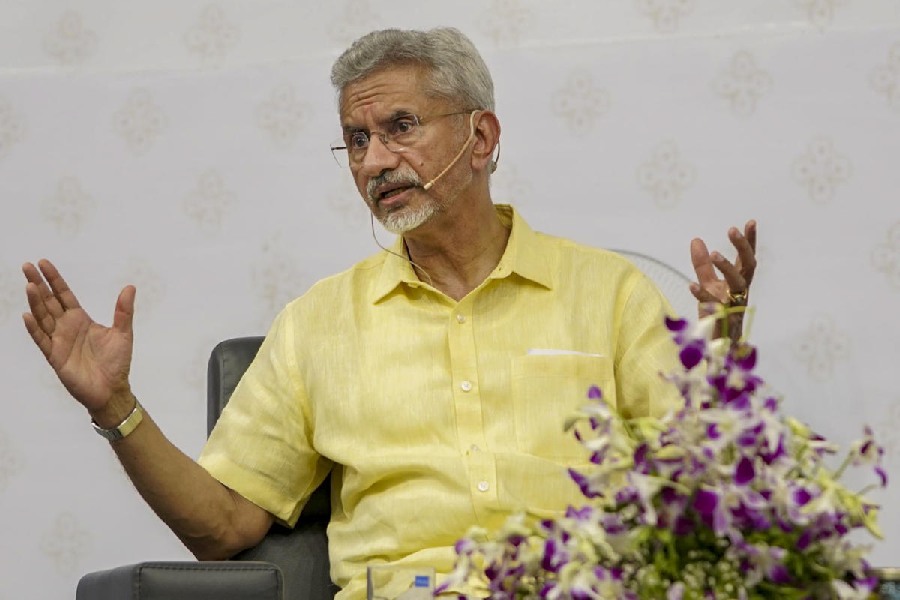 |
| The wall guarding the mega power project site at Nabinagar in Aurangabad. Picture by Suman |
Nabinagar, Sept. 8: Nitish Kumar has thrown the gauntlet — improved electricity across the state, else he won’t seek votes — but the project that was to have driven his power dream is in urgent need of steam.
Work on the 3,960 (660X6) MW mega-project — that is to come up on 2,832 acres of land at Nabinagar, 30km southwest of the district headquarters of Aurangabad and 210km south of Patna — is progressing at snail’s pace. The main impediment to the project has come from farmers from 16 villages whose lands have been acquired; adding to the uncertainty is the government, which has only now woken to the fact that time is running out.
The project is one of 12 mega power plants coming up in India based on what engineers describe as “super critical technology” — which requires relatively less consumption of coal and causes little pollution. It is coming up on the banks of the river Sone, ensuring adequate supply of water that is a prime requirement for thermal plants. Besides, it is on the border of Jharkhand’s Hazaribagh district, which has a coalmine reserve nearby.
“Geographically, it is the most ideal site. When completed, the project will catapult Bihar to the league of top power generating states, luring entrepreneurs in a big way. It has the capability to produce power to meet the need of industrial investment. The huge power plant, which will have a cosmopolitan township on its premises, promises to change the culture and life in the region in particular and the state in general,” said O.P. Sharma, project officer and additional general manager of Nabinagar Power Generation Company Limited (NPGCL), a joint venture between NTPC and Bihar State Electricity Board.
But the ground reality tells a grim tale. The farmers have put up a hurdle for compensation. The government has been trying to talk its way through, with little success. The result: the deadline of 2015-16 appears a distant dream.
AMR, the Hyderabad company entrusted with the task of civil work, has barely completed 15 per cent of the boundary wall, without which the actual plant cannot be built. Against the 18km of wall needed around 2,832 acres of land, it has been able to build only about 2.5km.
Farmers have repeatedly stopped construction of the wall at a particular place on the ground that their compensation issue has not been settled. Much to the frustration of the AMR officials, some farmers have sown paddy on about seven acres of land on which the main plant and two water reservoirs are to come up. The green paddy crops are growing on the plots of land which were declared “acquired” way back in 2010.
“This should not be tolerated. Now these farmers are asking for compensation against the crops they have wilfully sown,” said a frustrated AMR official, who did not wish to be named. “Holding batons in hands, they gather at will to stop the workers from going about their job. We have no way out but to listen to them as we are under strict instructions (from the powers-that-be) not to use force. There is a special police station for the protection of the plant, workers and officials. But the policemen stay mute spectators when they see hoodlums stopping us from doing the work.”
The lack of any precise policy on part of the government on how to approach the problem is what is worrying those in charge of building the plant.
“After all, the farmers’ votes are as dear to Nitishji as the power plant. We have to walk the tightrope as we can’t get tough with the farmers and at the same time we can ill-afford to ignore the chief minister’s instructions to speed up the progress on his dream project,” a senior administrative official said on condition of anonymity.
NPGCL officials fear that the delay could lead to cost escalation and complicate the situation.
A senior NPGCL engineer, who did not wish to be named as he was not authorised to speak on the subject, pointed out that 2,832 acres was needed for building the main plant (1000 acres), township (1,000 acres) and ash drive (about 700 acres). “Effectively, we so far have possession of only 600 acres to work on. We need the effective acquisition of all 2,832 acres as soon as possible and complete the boundary and earth filling work,” he said.
“Otherwise, BHEL, which has been given the job of building the main plant, might not turn up citing inflation and cost escalation,” the engineer added.
The estimated project cost of the plant is Rs 12,759.879 crore at 2010 prices.
The problem of compensation has been plaguing the project. Farmers had greeted the chief minister with shoes and batons when he visited the site on December 31 last year. Nitish ordered the raising of the compensation amount from Rs 13 lakh per acre to Rs 22 lakh per acre. He even invited the farmers to his 1 Aney Marg residence in Patna with the appeal: “We have not acquired land for giving it to some profit-making private company. It is for the overall well-being of the state. I need your cooperation and I will appreciate your sacrifice.”
But the farmers now want more. “Prices are rising. We should be paid at the rate of Rs 30 lakh per acre,” said Ambika Singh, whose 52 acres of land have fallen within the plant area.
The farmers say the administration had connived with NGPCL to deny the landowners their rightful due. Arun Kumar Singh, convener of the Displaced Farmers’ Struggle Committee — a forum of the agitating farmers — met The Telegraph with a thick file to prove their point.
“They (officials) have fiddled with our land records. They have awarded compensation to Y for land that belonged to X. They have referred 247 cases of compensation claim to the court. We are willing to give our land for the power project. But one cannot cheat us,” said Singh, who has six acres of land within the plant’s premises.
District officials did not deny outright the farmers’ allegation that compensation money has in many cases been paid to those not actually owning the land.
“The government has not updated the land records for decades. The records are confusing and primitive. When we ask for valid proof — land receipts, sale deeds, transfer deeds etc — they cant produce them. Moreover, most of the land is in the name of the landowners’ forefathers who are no more. Thus, maintaining exactness in such an exercise is well nigh impossible,” said a senior official at the land acquisition office.
As a step to assuage the farmers, the government replaced Birendra Paswan with G.K. Mishra as the land acquisition officer for the plant about a month ago. “I joined office on August 9 and by now I have paid compensation against over 200 acres of land. I organise camps at the affected villages and sort out the real occupants on the spot with the help of karmcharis (local land clerks) and villagers. I am sure that the land compensation issue would be sorted out by the end of the month,” Mishra told The Telegraph.
A senior NPGCL engineer said all greenfield projects face initial hurdles. “I have worked in setting up 11 power plants and almost all of them have suffered from such teething problems. These problems will be over once the boundary wall is completed and the CISF is deployed. There are hurdles but eventually we will have our way,” he said.
But few are optimistic that the project would meet its 2015-16 deadline. “We are sure that Nitish’s second term (2010-15) will not see it completed. But we are also sure that the project will become reality one day,” said the engineer.
Nitish can only hope that that “one day” dawns sooner rather than later.










